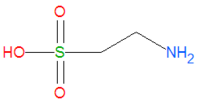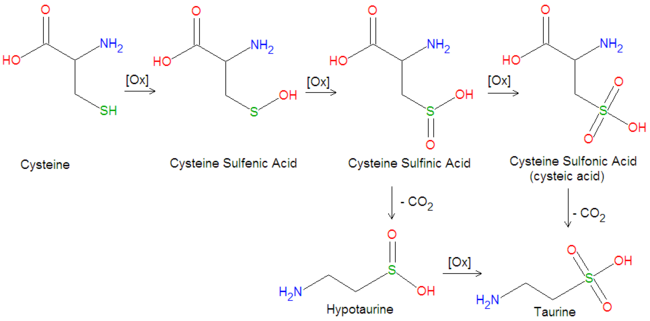Taurine
Taurine, or 2-aminoethanesulfonic acid, is a natural biochemical produced by many, but not all, animals, and is a major constituent of bile. It is often referred to as an amino acid despite the fact that it does not contain a carboxylic acid group like most amino acids do. It plays an important role in the phase II detoxification of the liver by forming water soluble salts which can be excreted. Chemically, it is one of the few naturally occurring sulfonic acids and it a derivative of cysteine, another amino acid important in liver detoxification.
Biosynthesis
Taurine is created enzymatically from L-cysteine by several oxidation reactions and a single decarboxylation step, as illustated in the figure. In the first oxidation step, the hydrogen on the sulfur atom is replaced with an hydroxyl group (OH), creating a sulfenic acid, cysteine sulfenic acid. The second oxidation adds another oxygen atom to produce a sulfinic acid, cysteine sulfinic acid. A third oxidation step adds another oxygen atom to form a sulfonic acid, cysteine sulfonic acid, also called cysteic acid. An enzymatic decarboxylation reaction, in which carbon dioxide (CO2) is removed, produces taurine. In an alternative pathway, the decarboxylation step may precede the final oxidation. Thus, decarboxylation of cystein sulfinic acid produces hypocysteine, which can be subsequently oxidized to form taurine.
Metabolism
Taurine is metabolized by a variety of pathways.[1] It can be transformed into 5-glutamyl-taurine, taurocyanamine and taurocyanamine phosphate, sulfoacetaldehyde, sulfoacetate, the bile salts taurocholate and taurochenodeoxycholate, and aminoacetaldehyde.
Bile Salts
Bile salts are derived from the conversion of cholesterol into steroid carboxylic acids, which are then conjugated with either taurine or glycine before excretion as bile into the digestive tract. The two most common bile acids are cholic acid and chenodeoxycholic acid, which get converted into taurocholate, glycocholate, taurochenodeoxycholate or glycochenodeoxycholate, the most common bile salts.

